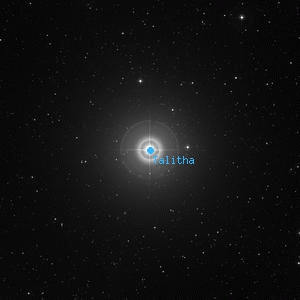Talitha

Overlaid DSS image of Talitha, 60' x 60' with north at top and west to the right
Aladin viewer for the region around Talitha
Talitha Borealis, Iota Ursae Majoris, ι UMa, 9 UMa
BD+48 1707, HD 76644, HR 3569, SAO 42630, HIP 44127, WDS J08592+4803A,BC, WDS J08592+4803A,BC
BD+48 1707, HD 76644, HR 3569, SAO 42630, HIP 44127, WDS J08592+4803A,BC, WDS J08592+4803A,BC
| Type | Star |
|---|---|
| Magnitude | 3.14 | Right Ascension | 8h 59' 12.5" (2000) |
| Declination | 48° 2' 30" N |
| Constellation | Ursa Major |
| Classification | A6 |
Observing Notes
Andrew Cooper
Feb 20, 2020 Waikoloa, HI (map)
20cm f/6 Newtonian, Cave Astrola @ 61x
Seeing: 7 Transparency: 6 Moon: 0%
White, no companion noted
Captain William Henry Smyth
Feb 13, 1839 No. 6 The Crescent, Bedford, England (map)
150mm f/17.6 refractor by Tully 1827
A Greenwich star of 1830, double, and in the Great Bear's right fore-paw; where it may be readily identified by shooting a west-south-west ray from β, the southern-most of the two pointers, which will pass through θ at nearly 12, then at half that distance further on will strike ι. A 3½, topaz yellow; B 13, purple. This fine object was discovered by H., being No. 2477 of his 20-foot Sweeps; and as I was desirous of recent micrometric measures for comparison, Mr. Challis was kind enough to send me the following, taken expressly with the great Northumberland equatoreal:Pos. 350° 02' Dist. 10".68 Ep. 1841.19There is a star of the 8th magnitude preceding at an angle =268°.7, with Δ RA=52s.9, which is that mentioned by Piazzi in Note 212 of Hora VIII. A is charged with very sensible proper motions, to the following amount:
[WDS 90° 2".4 2017 ]P.... RA -1".05 Dec. -0".32From strong impressions on his mind, confirmed by what he saw in the Southern Hemisphere, Sir John Herschel supposes that certain very minute companions to stars may possibly shine by reflected light; and ι Ursæ is one of those instanced as having a dull satellite.
B.... -0".63 -0".28
A.... -0".66 -0".29
[Hipparcos -0".44129 -0".21532]
This star has obtained the name of Talita, the third vertebra, the meaning of which is not quite clear. Ulugh Beigh has it Al Phikra Al Thálitha, perhaps for Al Kafzah al-thálithah, the third spring, or leap, of the ghazal. This was applied by the Arab star-gazers to ι and κ; the first leap, al-úla, being ν and ξ; and the second, al-thániyah, was δ and μ. As Ideler found this as well in Tízíní's Catalogue as on the Cufic globes at Dresden, he adopted the antelope, though the purport of it is not very obvious. Hyde contrives to render it either the vertebræ of the Great Bear, or the cavity of his heel: but, as Ideler remarks, the Arabic names of the stars indicate an ancient sphere, different from that which their later astronomers modified from Ptolemy.― A Cycle of Celestial Objects Vol II, The Bedford Catalogue, William Henry Smyth, 1844
Other Data Sources for Talitha
Nearby objects for Talitha
10 objects found within 120'
| Alkaphrah | HD 77601 | NGC 2676 |
| NGC 2684 | NGC 2686 | NGC 2686B |
| NGC 2687A | NGC 2687B | |
| NGC 2689 |
Credits...
Drawings, descriptions, and CCD photos are copyright Andrew Cooper unless otherwise noted, no usage without permission.
A complete list of credits and sources can be found on the about page
Talitha